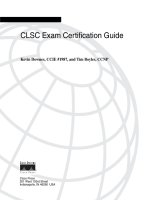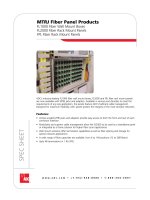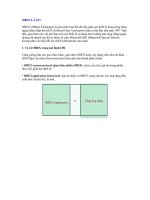Tài liệu E Creating Using Account pptx
Bạn đang xem bản rút gọn của tài liệu. Xem và tải ngay bản đầy đủ của tài liệu tại đây (357.32 KB, 25 trang )
CertPrs8 / MCAD/MCSD XML Web Services and Server Components Development with Visual Basic .NET / Lind / 222653-6 /
Chapter E
E
Creating User
Accounts
P:\010Comp\CertPrs8\653-6\appe.vp
Wednesday, October 30, 2002 9:48:41 AM
Color profile: Generic CMYK printer profile
Composite Default screen
CertPrs8 / MCAD/MCSD XML Web Services and Server Components Development with Visual Basic .NET / Lind /
222653-6 / Appendix E
T
his appendix contains explanations of how to create user accounts for use in the
Windows environment. If you want a brief overview of Active Directory, just keep
reading. If you are looking for specifics about how to create domain, local, or SQL
Server user accounts, you can just jump to those sections.
The network you will need to try the domain exercises in this appendix consist of
a Windows 2000 server configured to be a domain controller, and a Windows 2000
Professional workstation that is used to control local accounts.
The Windows Authentication Scheme
In every computer network starting with the mainframe through the first office local
area networks (LANs) to today’s enterprise networks, there has always been a need
to simplify authentication of the user’s credentials.
Authentication started out with a local database of user names and passwords in
the mainframe that the user had to be authenticated against before getting access to
any resources on the mainframe. When a second mainframe was needed, the user
had to authenticate against that mainframe’s database—usually with a different user
name and password.
In the LAN environment that connected together a number of users to file and
print servers, the LAN used a central database that the user authenticated against
in order the gain access to the LAN’s resources. If the same user needed access to
multiple LANs, there would be multiple user name and password combinations for
each LAN.
That was the situation that virtually all companies faced during the early part
of the 1990s. Multiple user name–password combinations were proliferating
that the end user needed to remember and that needed to be managed. The
solution was to combine all the locally maintained databases into one central
database where the authentication information was stored and that provided a
centralized authentication service.
A number of different solutions were proposed, and some were developed into
centralized authentication products. What has emerged are a couple of standards
that go beyond just keeping user authentication information. These standards define
how to keep information about the users, computers, printers, offices—as a matter
of fact, anything you want to keep track of in a directory (very much like the white
pages directory) that can be used by anyone in the network. What follows is a list
2
Appendix E: Creating User Accounts
CertPrs8 / MCAD/MCSD XML Web Services and Server Components Development with Visual Basic .NET / Lind /
222653-6 / Appendix E
P:\010Comp\CertPrs8\653-6\appe.vp
Wednesday, October 30, 2002 9:48:41 AM
Color profile: Generic CMYK printer profile
Composite Default screen
The Windows Authentication Scheme
3
CertPrs8 / MCAD/MCSD XML Web Services and Server Components Development with Visual Basic .NET / Lind /
222653-6 / Appendix E
of the standards that form the base of the current directory service used in the
Microsoft environment:
■
X.500 The standard that defines how to store and query information
about objects that are stored in the directory
■
Kerberos V5 A software component that allows for a very scalable
authentication architecture
■
LDAP The Lightweight Directory Access Protocol, the standard
communication protocol that is used with X.500
Take a closer look at these standards.
X.500
The X.500 standard was developed to store directory information about objects
in such a way that the information would be unique and searchable. The standard
is based on the Comité Consultatif International Téléphonique et Télégraphique
(International Telephone and Telegraph Consultative Committee, or CCITT)
Recommendations X.500 and the associated APIA–X/OPEN API specifications.
The best example of how X.500 works is the standard white pages that we all use
to find the phone number of an individual.
You can browse the white pages and search for information according to the
individual’s last name sorted from A to Z. By browsing according to the alphabetic
sorting, you can find the information you require. A possibly more refined method
is illustrated by the yellow pages, where the information is filtered on businesses
and sorted on business category.
The X.500 directory service is a system designed to manage detailed information
about network objects that include users, services, systems, applications, and the
enterprise itself. The highlights of X.500 include
■
Distributed directory The X.500 database is distributed across the network.
■
Simplified management All management is performed locally. Each part
of the X.500 environment is responsible for its own information.
■
Standards The X.500 standard is based on a number of protocols that have
been approved by the CCITT, the International Telecommunication Union
(ITU), and the International Organization for Standardization (ISO).
P:\010Comp\CertPrs8\653-6\appe.vp
Wednesday, October 30, 2002 9:48:41 AM
Color profile: Generic CMYK printer profile
Composite Default screen
■
Querying X.500 supports powerful querying of the information stored in
the directory.
■
Single namespace X.500 supports a single namespace based on the
organization’s name (O). This support for a homogeneous namespace lets
X.500 support distinguished names and relative distinguished names. A
distinguished name is unique within the namespace (global), while a relative
distinguished name is unique within the immediate location of the name
(local scope).
■
Objects The objects in X.500 are defined using the organization (O),
organizational unit (OU), and common name (CN) objects. This allows a
very fine-grained definition of any object in the organization.
Kerberos V5
Kerberos is an authentication system that performs mutual authentication. Kerberos
can be looked on as the notary public that is trusted by everyone to be honestly and
incorruptibly performing the authentication task. One example that explains the
role of Kerberos is the following used car purchase story.
Greg is going to purchase a used car from Honest Joe in what should be a very
straightforward business transaction, but there is a small problem. Greg only has a
blank check in his pocket, and he wants to pay for the car with that check.
Honest Joe is honest, not gullible, so he demands some proof that Greg is not
a con artist who will hand over a rubber check and then make a run for it in his
new wheels.
So there you are. Greg says give me the car for this check, while Honest Joe says,
prove to me that you are honest as well, then I’ll give you the car. This is a standoff
situation that is a classic deadlock.
The solution is Kerberos. Kerberos is the notary public in the town where Honest
Joe has his used car lot. Greg sends an encoded message over to Kerberos requesting
permission to communicate. Kerberos takes the request and encodes it in such a way
that Greg can validate that only Kerberos could have sent the message back. This is
how Kerberos ensures that he is recognized as a notary public. The technical name
for this message is a ticket-granting ticket (TGT).
Greg now sends a new message back to Kerberos requesting that he be validated
to purchase a car from Honest Joe with a check. This request is encoded in such a
way that Kerberos can validate that Greg is truly the Greg that is asking for permission.
4
Appendix E: Creating User Accounts
CertPrs8 / MCAD/MCSD XML Web Services and Server Components Development with Visual Basic .NET / Lind /
222653-6 / Appendix E
P:\010Comp\CertPrs8\653-6\appe.vp
Wednesday, October 30, 2002 9:48:41 AM
Color profile: Generic CMYK printer profile
Composite Default screen
Kerberos calls his contacts downtown that tell him that Greg has money in the bank
and that Greg is as honest as he claims to be.
Kerberos sends this information back to Greg, encoded in such a way that when
Greg hands this message over, Honest Joe is the only person that can read the
approval and confirm that Kerberos approved. The technical name for this message
is the ticket.
There are timestamps in all these messages to ensure that if someone managed
to intercept a message and tried to perform a man-in-the-middle security attack,
the impact would be very minimal if any.
LDAP
The original protocol that was designed to work with X.500 was the Directory
Access Protocol (DAP). This protocol was considered heavy, because it relied on
a local X.500 node. As part of the further development of X.500, a new protocol
was developed: the Lightweight Directory Access Protocol (LDAP).
LDAP is one of the Internet standards and is based on a number of Requests
for Comments (RFCs), namely 1777, 1778, and 2251. The function of LDAP is
to provide support for querying a directory service.
It is through LDAP that a client can access the directory for information about an
object. LDAP also defines how a directory service stores the directory information
and how it names the directory objects.
Active Directory
Microsoft presented Active Directory (AD) when Windows 2000 was released. This
appendix is not meant to teach you the finer points about Active Directory. Rather,
I aim at introducing the parts of Active Directory that will be a basis for how you
create user accounts.
Active Directory is a logical representation of the objects in a network and organizes
those objects using the organization (O), organizational unit (OU), and common
name (CN) objects.
The primary logical objects that are related to Active Directory are domains,
trees, forests, and lower-level objects. Active Directory uses the Domain Name
System (DNS) to name the three high-level objects (domain, tree, and forest).
This dependence on the Internet standard DNS is crucial to Active Directory.
The Windows Authentication Scheme
5
CertPrs8 / MCAD/MCSD XML Web Services and Server Components Development with Visual Basic .NET / Lind /
222653-6 / Appendix E
P:\010Comp\CertPrs8\653-6\appe.vp
Wednesday, October 30, 2002 9:48:41 AM
Color profile: Generic CMYK printer profile
Composite Default screen
Domains
Windows 2000 domains are very similar to the domains that were used in Windows
NT. They are containers of objects that share:
■
Security requirements
■
Replication processes
■
Administration
Domains are the core unit of Active Directory and usually take on your registered
Internet name. Domains can be grouped hierarchically, where the top-level domain
is called the parent domain and the lower-level domains are child domains.
In Figure E-1, you can see how the domains are depicted as triangles.
Tree
Trees are collections of domains that share the same root domain name (namespace).
Normally only large enterprises will be concerned with trees. The tree is based on
the common namespace and is purely logical.
In Figure E-1, you can see two trees. The tree is represented by the lines that
connect the domains.
Forests
A forest is a collection of trees, as in the real world. The forest is the highest-level
object in Active Directory. The forest connects different namespaces together so
that resources can be shared between multiple entities.
Common reasons for forests are that two companies merge but want to maintain
their namespaces, or that two companies want to make some resources available to
trading partners and/or customers.
In Figure E-1, you can see the forest that is made up of two trees.
Organizational Units
The organizational unit (OU) represents a logical administrative unit. The OU is a
container that holds other objects, such as nested OUs, users, computers, printers,
and so on.
In Figure E-1, you can see the representation of the OU as a circle; it is in effect
a container.
6
Appendix E: Creating User Accounts
CertPrs8 / MCAD/MCSD XML Web Services and Server Components Development with Visual Basic .NET / Lind /
222653-6 / Appendix E
P:\010Comp\CertPrs8\653-6\appe.vp
Wednesday, October 30, 2002 9:48:41 AM
Color profile: Generic CMYK printer profile
Composite Default screen
Sites
The site is a representation of the objects that are physically connected together. Sites
are used to define communication links rather than as administrative boundaries.
The user accounts belong in an OU that in turn is part of a domain. This
structure together with the Active Directory services that Windows 2000 provides
makes the account usable through the entire forest. The user account can be
authenticated from any computer in the forest.
The Windows Authentication Scheme
7
CertPrs8 / MCAD/MCSD XML Web Services and Server Components Development with Visual Basic .NET / Lind /
222653-6 / Appendix E
FIGURE E-1
Active Directory details
P:\010Comp\CertPrs8\653-6\appe.vp
Wednesday, October 30, 2002 9:48:42 AM
Color profile: Generic CMYK printer profile
Composite Default screen
CertPrs8 / MCAD/MCSD XML Web Services and Server Components Development with Visual Basic .NET / Lind /
222653-6 / Appendix E
The other type of account that is available is the local user account that is stored
in a local security database. These accounts are available only on the local computer.
Creating an Account in a Domain
User accounts for use in domains are created using the Active Directory Users
and Computers console, which is available from Start | Settings | Control Panel |
Administrative Tools, or Start | Programs | Administrative Tools if the Administrative
Tools option is turned on.
EXERCISE E-1
Creating a Domain Account
In this exercise, you will go through the steps of creating a user account in a domain.
For this exercise to work, you will need to have a defined domain, and you must
have administrative permissions for that domain.
1.
Open the Active Directory Users and Computers console that is available
from Start | Settings | Control Panel | Administrative Tools.
The domain name shown here is the domain name used in my office. You
will see the domain name of your organization.
2.
Click the Users container in the left panel.
3.
The right panel will show the users and groups that are already defined for
your domain.
4.
To start creating the user account, you will need to click the Action menu.
Select New | User.
8
Appendix E: Creating User Accounts
CertPrs8 / MCAD/MCSD XML Web Services and Server Components Development with Visual Basic .NET / Lind /
222653-6 / Appendix E
P:\010Comp\CertPrs8\653-6\appe.vp
Wednesday, October 30, 2002 9:48:42 AM
Color profile: Generic CMYK printer profile
Composite Default screen
Creating an Account in a Domain
9
CertPrs8 / MCAD/MCSD XML Web Services and Server Components Development with Visual Basic .NET / Lind /
222653-6 / Appendix E
5.
In the New Object – User dialog, you will need to fill in the information
about the user.
The name of the user is self explanatory, but the logon name might not be.
The logon name forms a unique combination together with the domain
P:\010Comp\CertPrs8\653-6\appe.vp
Wednesday, October 30, 2002 9:48:42 AM
Color profile: Generic CMYK printer profile
Composite Default screen
10
Appendix E: Creating User Accounts
CertPrs8 / MCAD/MCSD XML Web Services and Server Components Development with Visual Basic .NET / Lind /
222653-6 / Appendix E
name that is called the distinguished name (DN). If you were to use a
duplicate name, the system would ask you to change to a unique name.
6.
Click Next. The second part of the New Object – User dialog is displayed.
7.
Enter and confirm the password.
8.
There are four options regarding the password:
■
User must change password at next login Select this option to force
the user to pick a new password when she logs in.
■
User cannot change password Select this option to make it impossible
for a user to change the password. You will use this setting for service
accounts that are used to authenticate Windows Services.
■
Password never expires Select this option for those accounts that
always must be available, such as service accounts.
■
Account disabled Select this option when accounts are created that
will not be used until a later time.
P:\010Comp\CertPrs8\653-6\appe.vp
Wednesday, October 30, 2002 9:48:42 AM
Color profile: Generic CMYK printer profile
Composite Default screen









